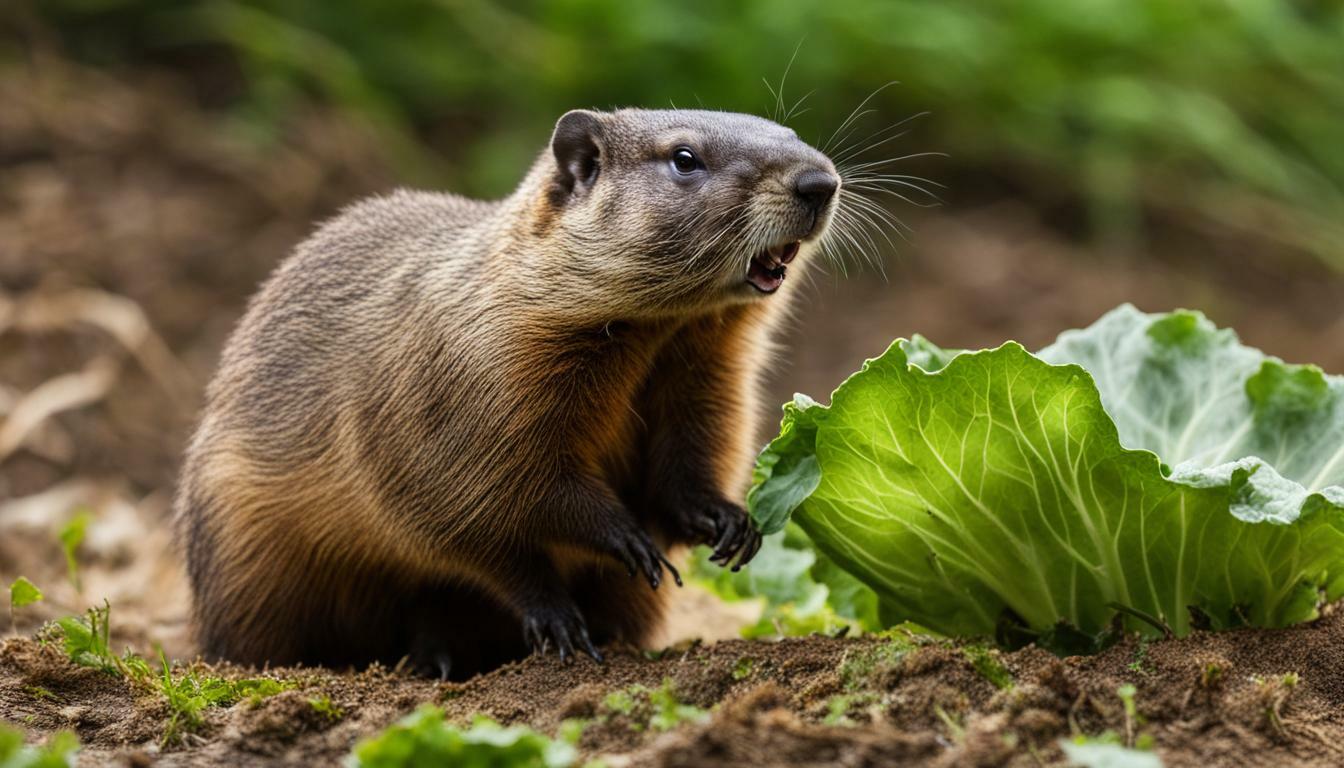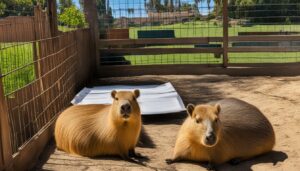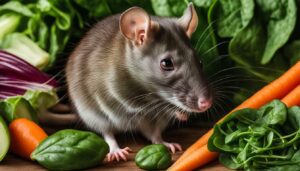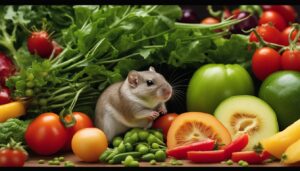Groundhogs, also known as woodchucks, are herbivores and have a varied diet that includes plants like cabbage. These chubby little creatures can cause significant damage to gardens, including the consumption of cabbage. Let’s explore the dietary habits of groundhogs and their love for this leafy vegetable.
Key Takeaways:
- Groundhogs are herbivores and enjoy a diet mainly consisting of plants.
- Cabbage is a popular food choice for groundhogs due to its tender leaves and easy availability in gardens.
- Groundhogs may eat cabbage for various reasons, including its nutritional content, palatability, and seasonal factors.
- To protect crops from groundhogs, deterrents such as ultrasonic repeller devices, natural scents, repellents, fencing, live traps, and scarecrows can be used.
- Other animals, such as rabbits, deer, slugs, snails, cabbage loopers, and cabbage worms, may also consume cabbage plants.
What Do Groundhogs Eat?
Groundhogs primarily feed on plants, including grasses, weeds, and garden crops. As herbivores, their diet consists mainly of foliage, stems, and leaves. Groundhogs are known to have a preference for fresh and tender vegetation, making gardens a prime target for their feeding habits.
When it comes to their food preferences, groundhogs tend to consume a variety of plant species. They enjoy feasting on crops such as lettuce, carrots, beans, peas, and, yes, even cabbage. The tender leaves of cabbage make it an attractive option for these furry critters, and its accessibility in gardens further enhances its appeal.
Groundhogs are most active during the spring and summer months, as they need to build up their fat reserves for hibernation. This period coincides with the time when gardens are abundant with fresh produce. The availability of cabbage and other garden crops plays a significant role in groundhogs’ diet during this period.
| Groundhog’s Food Preferences: |
|---|
| Grasses |
| Weeds |
| Garden crops (including cabbage) |
While groundhogs’ fondness for cabbage can lead to garden damage, there are various deterrents that can be implemented to protect your crops. Ultrasonic repeller devices emit high-frequency sound waves that deter groundhogs from entering the area. Natural scents like garlic and hot pepper can also repel these critters. Additionally, physical barriers such as fencing and the strategic placement of scarecrows can help keep them at bay. If necessary, live traps can be used to relocate groundhogs.
It’s important to note that groundhogs are not the only animals that may target cabbage plants. Other culprits include rabbits, deer, slugs, snails, cabbage loopers, and cabbage worms. Implementing measures to protect your garden from these various pests can help ensure a healthy crop of cabbage and other vegetables.
Groundhogs and Cabbage Consumption
Cabbage is a popular food choice for groundhogs due to its tender leaves and availability in gardens. Groundhogs, also known as woodchucks, are herbivores and their diet consists mainly of plants, including grasses, weeds, and garden crops. Their love for cabbage can pose a problem for gardeners, as groundhogs can cause significant damage to crops.
Groundhogs may eat cabbage for various reasons. Firstly, cabbage is readily available in gardens and provides an easy food source for these curious creatures. Additionally, cabbage is rich in essential nutrients, such as vitamins K and C, as well as dietary fiber. The high nutritional content and palatability of cabbage make it an attractive choice for groundhogs.
Seasonal factors also play a role in groundhogs’ consumption of cabbage. These animals are most active during the spring and summer months when they need to build up their fat reserves for hibernation. During this time, they are more likely to seek out food sources like cabbage to fuel their energy needs.
Protecting Your Garden from Groundhogs
If you want to prevent groundhogs from devouring your cabbage and other plants, there are several deterrents you can try. One option is to use ultrasonic repeller devices that emit high-frequency sounds that are unpleasant to groundhogs. Another method is to use natural scents, such as garlic or predator urine, to create an unfriendly environment for these pests.
Repellents, such as those containing hot pepper or castor oil, can also be effective in deterring groundhogs. Fencing your garden with wire mesh buried at least a foot deep can create a physical barrier and prevent these animals from accessing your plants. Live traps can be used to capture groundhogs and then release them in a more suitable location away from your garden. Lastly, scarecrows can help frighten groundhogs and keep them at bay.
It’s important to protect your crops from groundhogs, as their feeding habits can cause damage not only to the produce but also to the garden structure. Keep in mind that groundhogs are not the only animals that may eat cabbage plants. Other common culprits include rabbits, deer, slugs, snails, cabbage loopers, and cabbage worms. Taking proactive measures to safeguard your garden can help ensure a bountiful harvest.
| Groundhogs and Cabbage Consumption | Groundhog Diet and Nutrition | Cabbage and Groundhog’s Diet |
|---|---|---|
| Groundhogs eat cabbage due to its tender leaves and availability in gardens. | Groundhogs are herbivores and mainly consume plants like grasses, weeds, and garden crops. | Cabbage is a preferred food choice for groundhogs, offering nutritional value and palatability. |
| Seasonal factors, such as spring and summer months, can influence groundhogs’ cabbage consumption. | Groundhogs are most active during spring and summer as they prepare for hibernation. | Groundhogs seek out cabbage to build up fat reserves and fuel their energy needs. |
| To prevent groundhogs from eating cabbage, various deterrents can be used such as ultrasonic repellers, natural scents, repellents, fencing, live traps, and scarecrows. Other animals that may consume cabbage plants include rabbits, deer, slugs, snails, cabbage loopers, and cabbage worms. | ||
Reasons Why Groundhogs Eat Cabbage
Groundhogs may eat cabbage for various reasons, such as its nutritional value and accessibility. Cabbage is rich in vitamins, minerals, and fiber, making it a nutritious option for these herbivorous creatures. The tender leaves of cabbage are also easily chewed and digested by groundhogs, making it a palatable choice for their diet.
Another reason groundhogs are drawn to cabbage is its availability in gardens. Groundhogs are known to be opportunistic feeders and will take advantage of easily accessible food sources. Gardens often provide an abundance of cabbage plants, making them an enticing target for these voracious eaters.
Furthermore, seasonal factors can influence groundhogs’ preference for cabbage. As groundhogs prepare for hibernation during the winter months, they need to build up their fat reserves. Cabbage, being a high-calorie food, can help groundhogs meet their energy requirements, aiding in their hibernation survival.
Other Vegetables Eaten by Groundhogs
While cabbage is a favorite among groundhogs, they are not limited to just this vegetable. Groundhogs have been known to consume a variety of other vegetables, including carrots, lettuce, kale, and broccoli. These vegetables offer similar nutritional benefits and are often found within gardens alongside cabbage.
| Vegetables Eaten by Groundhogs | Reasons for Consumption |
|---|---|
| Cabbage | Nutritional value, accessibility |
| Carrots | High in vitamins and minerals |
| Lettuce | Moisture-rich, palatable |
| Kale | Rich in antioxidants |
| Broccoli | High in fiber and vitamins |
It is important for gardeners to take measures to protect their crops from groundhogs and other animals that may consume cabbage plants. By implementing deterrents such as ultrasonic repeller devices, natural scents, repellents, fencing, live traps, and scarecrows, gardens can be safeguarded from the potential damage caused by these hungry critters.
Remember, groundhogs are not the only culprits when it comes to cabbage consumption. Other animals, such as rabbits, deer, slugs, snails, cabbage loopers, and cabbage worms, also have a taste for cabbage plants. Taking proactive steps to protect your garden can help ensure the success and abundance of your cabbage and other vegetable crops.
Groundhogs and Garden Damage
Groundhogs can cause damage to garden crops, including cabbage, as they have a voracious appetite. These herbivores primarily feed on plants, and their diet consists of a variety of vegetation such as grasses, weeds, and garden crops. The tender leaves of cabbage make it a popular choice for groundhogs, attracting them to gardens where this leafy vegetable is grown.
There are several reasons why groundhogs may eat cabbage. Firstly, cabbage is readily available in gardens, making it easily accessible for these critters. Additionally, cabbage is rich in nutrients, providing groundhogs with essential vitamins and minerals. Its palatability also plays a role, as groundhogs are known to favor certain flavors and textures. Lastly, seasonal factors influence their cabbage consumption, with groundhogs being most active during the spring and summer months when they need to build up their fat reserves.
To prevent groundhogs from feasting on cabbage and other plants, various deterrents can be employed. Ultrasonic repeller devices emit high-frequency sounds that are unpleasant to groundhogs, causing them to avoid the area. Natural scents like garlic or hot pepper spray can also deter these critters. Physical barriers such as fencing can be effective in keeping groundhogs out of gardens. Live traps can be used to capture them and relocate them to a more suitable habitat. Scarecrows are another option, as the presence of human-like figures can scare groundhogs away.
It is crucial to protect garden crops from groundhogs, as their feeding can cause significant damage. In addition to cabbage, other plants that may be targeted include lettuce, carrots, tomatoes, and beans. It is also worth noting that groundhogs are not the only animals that pose a threat to cabbage plants. Rabbits, deer, slugs, snails, cabbage loopers, and cabbage worms are among the other culprits that may feast on these leafy greens. Taking preventive measures and implementing deterrents can help safeguard gardens and the crops grown within.
| Groundhog Deterrents | Effectiveness |
|---|---|
| Ultrasonic repeller devices | Highly effective |
| Natural scents (garlic, hot pepper spray) | Moderately effective |
| Fencing | Highly effective |
| Live traps | Effective for relocation |
| Scarecrows | Effective in some cases |
Prevention and Deterrents for Groundhog Damage
To protect crops from groundhogs, there are several deterrents that can be employed. These methods are designed to discourage groundhogs from feasting on your cabbage and other garden plants, helping to preserve your harvest and maintain the integrity of your garden structure.
One effective deterrent is the use of ultrasonic repeller devices. These devices emit high-frequency sound waves that are unpleasant to groundhogs and can drive them away from your garden. They are easy to install and operate, providing a hassle-free solution to deter groundhogs.
Another option is to utilize natural scents that groundhogs find unappealing. A common method is to spread a mixture of garlic and chili powder around your garden. Groundhogs dislike the strong odor and spicy taste, making it less likely that they will venture near your crops.
Repellents are also available on the market, specifically designed to keep groundhogs at bay. These repellents often contain natural ingredients that emit a strong smell or taste that groundhogs dislike. By applying these repellents around your garden, you can create a barrier that discourages groundhogs from approaching your cabbage plants.
| Deterrent | Effectiveness |
|---|---|
| Ultrasonic Repeller Devices | High |
| Natural Scents | Medium |
| Repellents | Medium |
| Fencing | High |
| Live Traps | High |
| Scarecrows | Medium |
Fencing is another effective method to keep groundhogs away from your garden. Installing a fence that is at least 3 feet high and buried at least 1 foot underground can help prevent groundhogs from accessing your crops. It is important to ensure that the fencing is secure and has no gaps or openings that groundhogs can squeeze through.
If you are looking for a humane approach, live traps can be used to capture groundhogs without causing harm. Once captured, the groundhog can be safely relocated to a more suitable location away from your garden.
Lastly, scarecrows can serve as a visual deterrent to groundhogs. By placing scarecrows in your garden, you create the illusion of a human presence, which can deter groundhogs from approaching. Additionally, the movement of scarecrows in the wind can further discourage groundhogs from venturing into your garden.
By implementing these deterrents, you can help protect your cabbage plants from groundhog damage and ensure a bountiful harvest.
Other Animals that Eat Cabbage Plants
Groundhogs are not the only animals that have a taste for cabbage; other creatures like rabbits, deer, slugs, snails, cabbage loopers, and cabbage worms may also feed on cabbage plants. These animals are attracted to the tender leaves and nutritious properties of cabbage, making it a popular meal choice for them as well.
To better understand the impact of these animals on cabbage plants, let’s take a closer look at their feeding habits:
| Animal | Feeding Habits |
|---|---|
| Rabbits | Rabbits are herbivores that enjoy munching on cabbage leaves, often causing significant damage to the plants. |
| Deer | Deer are known to graze on various plants, including cabbage, which can result in the loss of entire crops if left uncontrolled. |
| Slugs and Snails | Slugs and snails are common pests in gardens, as they feed on various types of vegetation, including cabbage. Their feeding activity can lead to extensive damage if not addressed promptly. |
| Cabbage Loopers and Cabbage Worms | These caterpillars specifically target cabbage plants, feeding voraciously on the leaves and causing significant harm to the crops. |
Keeping these animals in check is essential for protecting cabbage plants from damage. Implementing effective pest control measures, such as using barriers, organic repellents, and regular inspection, can help safeguard your cabbage crops from these hungry intruders.
Remember, prevention is key when it comes to preserving your cabbage plants, so be proactive in monitoring and addressing any signs of animal activity. By taking the necessary steps to protect your crops, you can ensure a healthy and abundant harvest.
Groundhogs and Seasonal Activity
Groundhogs are most active during the spring and summer months when they need to build up their fat reserves. This is the time when they emerge from their winter hibernation and begin searching for food to sustain themselves. During these warmer months, groundhogs take advantage of the abundance of vegetation, including cabbage plants, to meet their nutritional needs.
As herbivores, groundhogs primarily feed on plants, including grasses, weeds, and various garden crops. Cabbage is particularly enticing to groundhogs due to its tender leaves and easy accessibility in gardens. The presence of cabbage plants provides a convenient and delicious food source for these furry creatures.
To protect your garden from groundhogs, it is important to understand their feeding habits and take appropriate measures. Aside from their preference for cabbage, groundhogs also consume other crops and plants, which can lead to significant damage to your garden. They have voracious appetites and can quickly decimate a cabbage patch or any other vegetable crops.
| Method | Effectiveness |
|---|---|
| Ultrasonic repeller devices | Varies depending on groundhog tolerance |
| Natural scents (e.g., garlic, chili peppers) | Can deter groundhogs temporarily |
| Repellents (e.g., predator urine) | May provide short-term protection |
| Fencing (at least 3 feet high, buried 1 foot deep) | Effective in preventing groundhog access |
| Live traps | Allows for safe relocation of groundhogs |
| Scarecrows | Can deter groundhogs through visual deterrent |
Using a combination of deterrents can increase the chances of protecting your cabbage plants and other crops from groundhog damage. For example, installing a sturdy fence around your garden can physically prevent groundhogs from accessing the area. Additionally, using ultrasonic repeller devices, natural scents, and scarecrows can further discourage groundhogs from venturing into your garden.
It is important to note that groundhogs are not the only animals that may eat cabbage plants. Other potential culprits include rabbits, deer, slugs, snails, cabbage loopers, and cabbage worms. Taking preventive measures against these critters can help safeguard your cabbage harvest and ensure the success of your garden.
| Animal | Prevention Methods |
|---|---|
| Rabbits | Fencing, repellents |
| Deer | Fencing, deer-resistant plants |
| Slugs and Snails | Slug and snail repellents, copper tape |
| Cabbage Loopers and Cabbage Worms | Row covers, organic insecticides |
By understanding groundhogs’ seasonal activity and employing effective deterrents, you can protect your cabbage plants and enjoy a bountiful harvest. Keep in mind the various preventive measures available, not only for groundhogs but also for other animals that may pose a threat to your garden.
Conclusion
Understanding groundhogs’ diet and preferences, including their consumption of cabbage, can help gardeners take appropriate steps to safeguard their crops.
Groundhogs are herbivores and have a varied diet consisting mainly of plants. They are known to eat grasses, weeds, and garden crops, with cabbage being a popular food choice. Cabbage is attractive to groundhogs due to its tender leaves and widespread availability in gardens.
There are several reasons why groundhogs eat cabbage. One reason is its nutritional content, as cabbage is rich in vitamins and minerals that contribute to the groundhogs’ overall health. Additionally, groundhogs find cabbage palatable and enjoy its taste. Another factor that influences their cabbage consumption is the seasonal availability of this vegetable. Groundhogs are most active during the spring and summer months and need to build up their fat reserves, making cabbage a convenient food source.
Protecting crops from groundhog damage is crucial for gardeners. To deter groundhogs from eating cabbage and other plants, various measures can be taken. These include using ultrasonic repeller devices, natural scents, repellents, fencing, live traps, and scarecrows. Implementing these deterrents can help prevent groundhogs from causing significant damage to both the produce and the garden structure.
It’s important to note that groundhogs are not the only animals that may eat cabbage plants. Other potential culprits include rabbits, deer, slugs, snails, cabbage loopers, and cabbage worms. Taking precautions to protect cabbage from these pests can further safeguard the crops.
FAQ
Do groundhogs eat cabbage?
Yes, groundhogs do eat cabbage as part of their diet.
What do groundhogs eat?
Groundhogs are herbivores and their diet consists mainly of plants, including grasses, weeds, and garden crops.
Why do groundhogs eat cabbage?
Groundhogs may eat cabbage due to its availability, nutritional content, palatability, and seasonal factors.
Can groundhogs cause damage to gardens?
Yes, groundhogs can cause significant damage to gardens by consuming plants, including cabbage.
How can I prevent groundhogs from eating cabbage?
Various deterrents can be used, such as ultrasonic repeller devices, natural scents, repellents, fencing, live traps, and scarecrows.
What other animals may eat cabbage plants?
Other animals that may eat cabbage plants include rabbits, deer, slugs, snails, cabbage loopers, and cabbage worms.
Are groundhogs more active during certain seasons?
Yes, groundhogs are most active during the spring and summer months when they need to build up their fat reserves.




